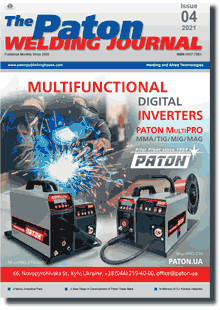| 2021 №04 (02) |
DOI of Article 10.37434/tpwj2021.04.03 |
2021 №04 (04) |

The Paton Welding Journal, 2021, #4, 14-19 pages
Influence of liquid glass characteristics on quality of coating formation of welding electrodes
A.E. Marchenko1, I.O. Glot2, M.V. Skoryna1
1E.O. Paton Electric Welding Institute of the NASU.. 11 Kazymyr Malevych Str., 03150, Kyiv, Ukraine. E-mail: office@paton.kiev.ua
2Institute of Continuous Media Mechanics of the Ural Branch of the RAS, 1, Academician Korolyov Str., 614018, Perm, Russia
Abstract
The viscosity of 6 % dispersions of Na-CMC in liquid Na- and K-glasses depending on temperature, as well as viscosity of pure liquid Na, K- and NaK-glasses depending on excess pressure and temperature was studied. Each of them represents a consistent medium of real electrode coating mixtures. With the use of the obtained results by mathematical methods, the functioning of the model of a joint effect of excess pressure and dissipative heating on viscosity, velocity profile and stability of pressure flow of electrode coating mixtures in the step channel under the conditions of coating formation by extrusion deposition on steel bars was verified. Although two competing sources of change in shear viscosity of the coating mass (temperature and pressure) are available, the calculations did not reveal situations with unstable (pulsating) flow modes through a suddenly narrowing channel, which could cause instability of the coating mixture flow and, therefore, electrode coatings with a thickness variation. At least, they were not revealed in the studied range of capillary sizes L/Rk < 10 and pressures, at which the electrodes are actually pressed. 10 Ref., 1 Table, 8 Figures.
Keywords: arc welding, coated electrodes, production technology, coating thickness variation, rheology, viscoelasticity of coatings
Received 22.03.2021
References
1. Cogswell, F.N. (1972) Converging flow of polymer melts in extrusion dies. Polym. Eng. and Sci., 12(2), 64-73. https://doi.org/10.1002/pen.7601201112. Kamal, M.R., Nuyn, H. (1980) Capillary viscometry a complete analysis including pressure and viscous heating effect. Ibid., 20(2), 109-119. https://doi.org/10.1002/pen.760200202
3. Marchenko, A.E., Skorina, N.V., Sidlin, Z.A., Kostyuchenko, V.P. (1992) Examination of viscosity of liquid glasses under pressure of electrode crimping. In: Proc. of Sci.-Tech. Seminar dedicated to the 100th Anniversary of the Birth of K.V. Petran on New Welding and Surfacing Materials and their Application in Industry (St.-Petersburg, 19-20 May, 1992). St.-Petersburg, 43-49 [in Russian].
4. Khodakov, G.S. (2003) Rheology of suspensions. Theory of phase flow and its experimental substantiation. Ros. Khim. Zhurnal, XLVII, 2, 33-44 [in Russian].
5. Vinogradov, G.V., Malkin, A.Ya. (1977) Rheology of polymers. Moscow, Khimiya [in Russian].
6. Ayler R.K. (1982) Chemistry of silica. In: 2 Pts, Pt.1. Ed. by V.P. Pryanishnikov. Moscow, Mir [in Russian].
7. Korneev, V.I., Danilov, V.V. (1996) Liquid and soluble glass. St.-Petersburg, Strojizdat [in Russian].
8. Marchenko, A.E., Skorina, N.V., Kiselev, M.O., Trachevsky, V.V. (2017) Nuclear magnetic spectroscopy study of the structure of liquid glasses for welding electrodes. The Paton Welding J., 1, 41-45. https://doi.org/10.15407/tpwj2017.01.07
9. Yankov, V.I., Glot, I.O., Trufanova, N.M., Shakirov, N.V. (2010) Flow of polymers in die holes. Theory, calculation, practice. Moscow, Izhevsk, ICI [in Russian].
10. Marchenko, A.E. (2015) On thermal environment created by viscous heating of electrode paste in the zone of formation of pressure flow. Welding materials - 2015 (Petran lectures). In: Proc. of Int. Sci.-Tech. Conf. (St.-Petersburg, 15-17 October, 2015). St.-Petersburg, 65-68.
Suggested Citation
A.E. Marchenko, I.O. Glot, M.V. Skoryna (2021) Influence of liquid glass characteristics on quality of coating formation of welding electrodes. The Paton Welding J., 04, 14-19.The cost of subscription/purchase order journals or individual articles
| Journal/Currency | Annual Set | 1 issue printed |
1 issue |
one article |
| TPWJ/USD | 384 $ | 32 $ | 26 $ | 13 $ |
| TPWJ/EUR | 348 € | 29 € | 24 € | 12 € |
| TPWJ/UAH | 7200 UAH | 600 UAH | 600 UAH | 280 UAH |
| AS/UAH | 1800 UAH | 300 UAH | 300 UAH | 150 UAH |
| AS/USD | 192 $ | 32 $ | 26 $ | 13 $ |
| AS/EUR | 180 € | 30 € | 25 € | 12 € |
| SEM/UAH | 1200 UAH | 300 UAH | 300 UAH | 150 UAH |
| SEM/USD | 128 $ | 32 $ | 26 $ | 13 $ |
| SEM/EUR | 120 € | 30 € | 25 € | 12 € |
| TDNK/UAH | 1200 UAH | 300 UAH | 300 UAH | 150 UAH |
| TDNK/USD | 128 $ | 32 $ | 26 $ | 13 $ |
| TDNK/EUR | 120 € | 30 € | 25 € | 15 € |
AS = «Automatic Welding» - 6 issues per year;
TPWJ = «PATON WELDING JOURNAL» - 12 issues per year;
SEM = «Electrometallurgy Today» - 4 issues per year;
TDNK = «Technical Diagnostics and Non-Destructive Testing» - 4 issues per year.


